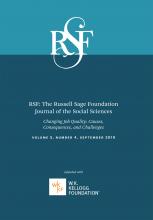Research Article
Open Access
Low-Wage Job Growth, Polarization, and the Limits and Opportunities of the Service Economy
Rachel E. Dwyer, Erik Olin Wright
RSF: The Russell Sage Foundation Journal of the Social Sciences September 2019, 5 (4) 56-76; DOI: https://doi.org/10.7758/RSF.2019.5.4.02
Rachel E. Dwyer
aProfessor of sociology at Ohio State University
Erik Olin Wright
bVilas Distinguished Research Professor of Sociology and director of the A.E. Havens Center for Social Justice at the University of Wisconsin-Madison

REFERENCES
- ↵
- Acemoglu, Daron, and
- David H. Autor
- ↵
- Acemoglu, Daron,
- David H. Autor,
- David Dorn,
- Gordon H. Hanson, and
- Brendan Price
- ↵
- Albelda, Randy,
- Mignon Duffy, and
- Nancy Folbre
- ↵
- Antonopoulos, Rania,
- Kijong Kim,
- Thomas Masterson, and
- Ajit Zacharias
- ↵
- Applebaum, Eileen,
- Annette Bernhardt, and
- Richard J. Murnane
- ↵
- ↵
- ↵
- Autor, David H.,
- David Dorn, and
- Gordon H. Hanson
- ↵
- Autor, David H.,
- Lawrence F. Katz, and
- Melissa S. Kearney
- ↵
- Autor, David H.,
- Lawrence F. Katz, and
- Melissa S. Kearney
- ↵
- Autor, David H.,
- Frank Levy, and
- Richard J. Murnane
- ↵
- Beaudry, Paul,
- David A. Green, and
- Benjamin M. Sand
- ↵
- Bureau of Labor Statistics (BLS)
- ↵
- Böhm, Michael J., and
- Daniel Metzger, and
- Per Strömberg
- ↵
- Cazes, Sandrine,
- Paolo Falco, and
- Balint Menyhért
- ↵
- Desmond, Matthew
- ↵
- Dickens, William T., and
- Lawrence F. Katz
- ↵
- Duffy, Mignon
- ↵
- Dwyer, Rachel E
- ↵
- England, Paula
- ↵
- ↵
- ↵
- Fernández-Macías, Enrique
- ↵
- Fernández-Macías, Enrique,
- Donald Storrie, and
- John Hurley
- ↵
- Folbre, Nancy
- Folbre, Nancy
- ↵
- Gaggl, Paul, and
- Sylvia Kaufmann
- ↵
- Gautié, Jérôme, and
- John Schmitt
- ↵
- ↵
- Goos, Maarten, and
- Alan Manning
- ↵
- Goos, Maarten,
- Alan Manning, and
- Anna Salomons
- ↵
- ↵
- Goos, Maarten,
- Emilie Rademakers,
- Anna Salomons, and
- Marieke Vandeweyer
- ↵
- Hirsch, Barry T., and
- Edward J. Schumacher
- Howell, David R
- ↵
- Howell, David R.,
- Ellen Houston, and
- William Milberg
- ↵
- ↵
- Hunt, Jennifer, and
- Ryan Nunn
- ↵
- Kalleberg, Arne L
- ↵
- Kochar, Rakesh
- ↵
- Kristal, Tali
- ↵
- Krueger, Alan B
- ↵
- Krueger, Alan B., and
- Lawrence H. Summers
- ↵
- Liu, Yujia, and
- David B. Grusky
- ↵
- López, Gustavo,
- Kristen Bialik, and
- Jynnah Radford
- ↵
- Manning, Alan
- ↵
- McCall, Leslie
- ↵
- Meyer, Peter B., and
- Anastasiya M. Osborne
- ↵
- Milkman, Ruth, and
- Rachel E. Dwyer
- ↵
- Mishel, Lawrence,
- John Schmitt, and
- Heidi Shierholz
- ↵
- Mouw, Ted, and
- Arne L. Kalleberg
- ↵
- National Bureau of Economic Research (NBER)
- ↵
- National Bureau of Economic Research (NBER)
- ↵
- ↵
- ↵
- Osterman, Paul, and
- Beth Shulman
- ↵
- Piketty, Thomas, and
- Emmanuel Saez
- ↵
- Pugh, Allison J
- ↵
- Rothstein, Jeffrey S
- ↵
- Sassen, Saskia
- ↵
- Tomaskovic-Devey, Donald
- ↵
- Tomaskovic-Devey, Donald, and
- Ken-Hou Lin
- ↵
- Tomaskovic-Devey, Donald, and
- Sheryl Skaggs
- ↵
- U.S. Census Bureau
- ↵
- ↵
- Wright, Erik Olin
- ↵
- Wright, Erik Olin
- ↵
In this issue
Low-Wage Job Growth, Polarization, and the Limits and Opportunities of the Service Economy
Rachel E. Dwyer, Erik Olin Wright
RSF: The Russell Sage Foundation Journal of the Social Sciences Sep 2019, 5 (4) 56-76; DOI: 10.7758/RSF.2019.5.4.02
Jump to section
Related Articles
- No related articles found.
Cited By...
- No citing articles found.





